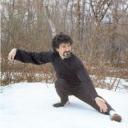Yahoo Answers is shutting down on May 4th, 2021 (Eastern Time) and beginning April 20th, 2021 (Eastern Time) the Yahoo Answers website will be in read-only mode. There will be no changes to other Yahoo properties or services, or your Yahoo account. You can find more information about the Yahoo Answers shutdown and how to download your data on this help page.
Trending News
Do you fight with loose, moving joints or tight locked joints?
Some martial artists keep the joints mobile and moving while fighting. This allows quicker response and more intricate movement. My style of Tai-chi-Chuan is like this. Other styles keep the joints tight until they are needed for a specific movement, the idea being that this protects the joints. Personally I find it hard to understand this second point of view. I would think that keeping tight just locks you up. Your ideas?
10 Answers
- callsignfuzzyLv 78 years agoFavorite Answer
I've never been taught or even heard of that second bit of advice. If your joints are tight, they're actually more susceptible to attack. It also makes it really hard to move, which is sort of the point of having joints. Everything I've ever trained- boxing, shoot wrestling, BJJ, Okinawan karate, Wing Chun, Kali, Jun Fan, Judo, Muay Thai, Keysi Fighting Method, Aikido, TKD- has emphasized staying relaxed until you have to attack.
- Anonymous8 years ago
I unfortunately had my journey in the wonderful martial art of Taijiquan cut down before it even began.But I still keep with my form everyday. I am working on sinking each joint into the ground. This was not a concept easy for me to grasp in the beginning. I had come from arts like Taekwondo, and being firm and upright was my signature. When I came to Taiji my root floated so to speak for quite some time. After attending a new school and learning the basics of Wuchi, I can now say I have improved greatly. I find myself more relaxed and able to generate more power and even some very weak Jing expressions in my forms that still need a ton of work. I am devoted to Taiji whole heartedly. And I will stand out there everyday doing my form (at least the little I was taught) until I find an opportunity to study again.
In my particular "Big Eight" set, the movements are very small frame, and the joints stay relaxed, sunk and rooted yet springy at all times.
Hope this was even worth reading. :)
EDIT: In my Kyokushin days, we would be pretty locked, but than again I was only a beginner, My Sensei always seemed far more relaxed.
- CharsisLv 48 years ago
You say it in your question, "allows quicker response and more intricate movement". There is your answer. Prove it, use a hit or kick you know well and feel "powerful" with the way you do it now, relaxed. Then try it as stiff and tight as you can. Which is stronger, which got to the target faster and which was more powerful.
Have you ever suddenly woken up from a dream or noise by either jumping up or (jolted) sitting up? When you do you do it extremely fast and probably faster than if you waited to wake up and tried to do it consciously. You know why you "jumped" out of bed or up so fast? Because your body was Absolutely relaxed, no tension. Your muscles just reacted. Loose and relaxed muscles are the most effective and strongest. At the point of impact they will need to tense up but thats it.
- Anonymous5 years ago
For Japanese martial art, Hapkido and Jujitsu have joint locking. For Chinese kungfu, most styles incorporate joint locking call Chin-na (or Qing-na). It is not a seperate style, but a discipline within each style. Any kind of joint locking can be defeated if not done quickly and precisely. Many of the technique might work on an unsuspecting or inexperienced fighter, but rarely on someone who is experienced or just plain berzerked. BJJ is good, but what are you going to do if you are attacked by more than one person?
- How do you think about the answers? You can sign in to vote the answer.
- wattylerLv 48 years ago
I guess both are necessary.As you point out keeping joints tight protects the joints yet this tension drains energy and decreases power and speed...
- ?Lv 48 years ago
I never keep my joints too tight because then I'd have a hard time preforming techniques. I do Tang Soo Do and we don't really fight loose but yet we don't fight stiff- it's in between.
- Kaleb AlemayehuLv 58 years ago
I personally don't follow a strict pattern, because one pattern may be good in one situation, but bad in another. Tight joints have their advantages and disadvantages, as well as loose joints. I say that you should customize to your environment OUTSIDE of the dojo.
- Jim RLv 78 years ago
The "looser" the better. By being tight, you can use up a lot of power.
By being loose you can transfer a lot of energy. You can also absorb energy with less damage if you remain loose.
So Bob, from a shotokan point of view, I agree with you about "loose".
- KokoroLv 78 years ago
To strike strong you must be relaxed.
So I agree you must be relaxed and not tight
Source(s): 30 yrs ma





